UCV Civil War Military Operations Marker #4: Battle of Shepherdstown, September 19-20, 1862
Introduction
Text-to-speech Audio
Images

Battle of Shepherdstown (map by Steven Stanley, American Battlefield Trust)
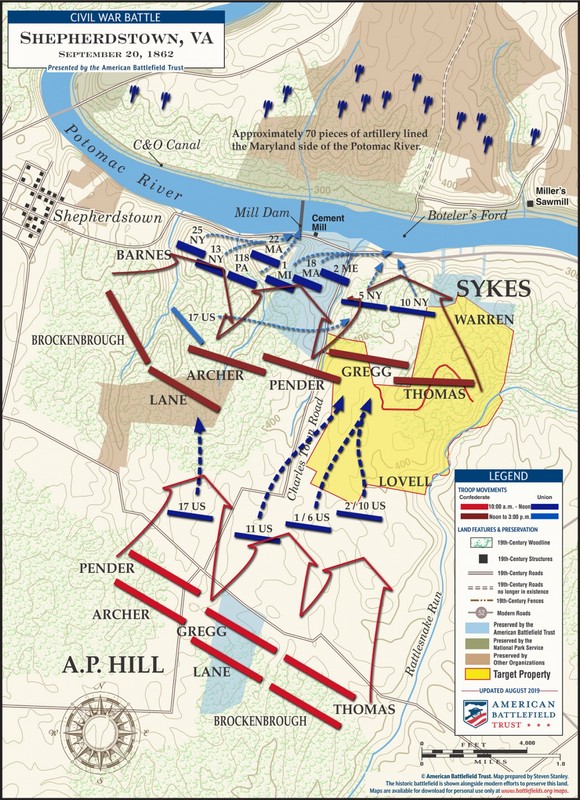
Map: September 19, 1862
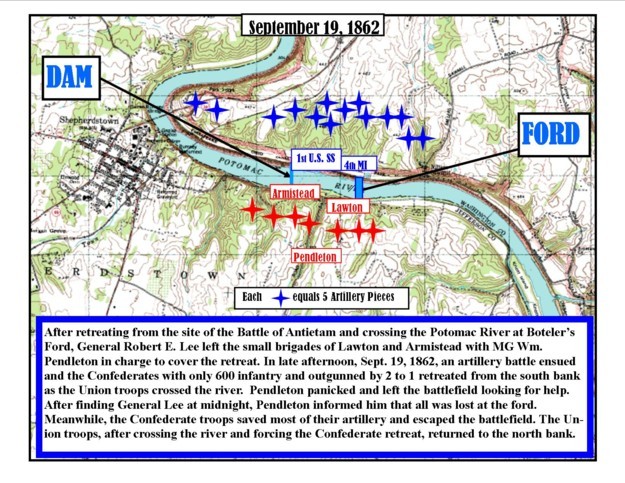
Map: September 20, 1862, 6AM-8AM
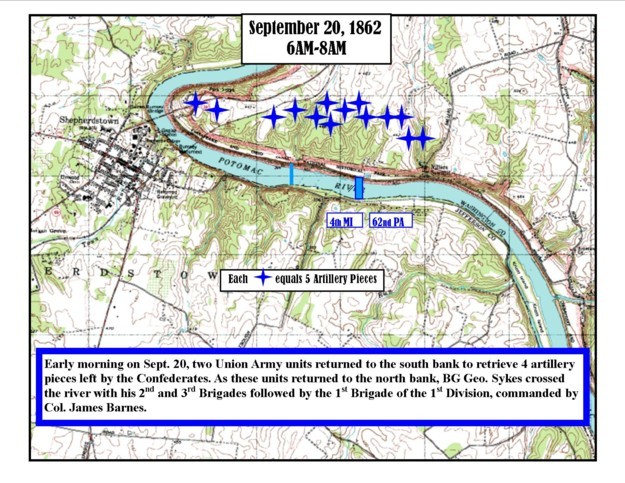
Map: September 20, 1862, 8AM-10AM
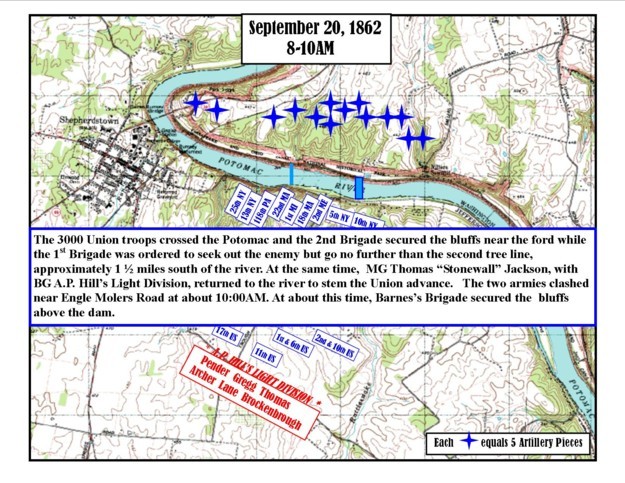
Map: September 20, 1862, 10AM-12PM
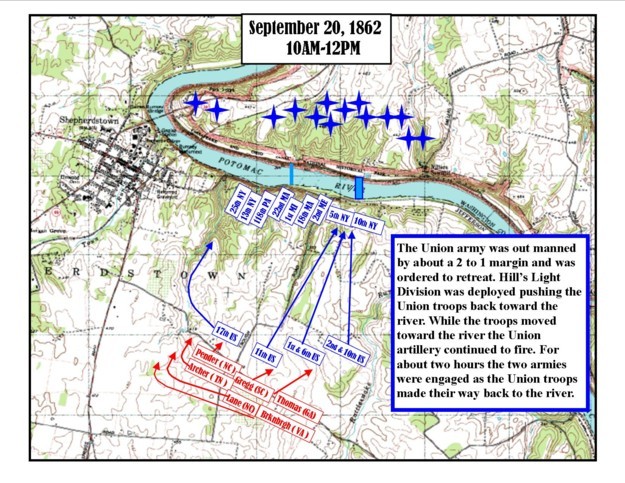
Map: September 20, 1862, 12PM-2PM
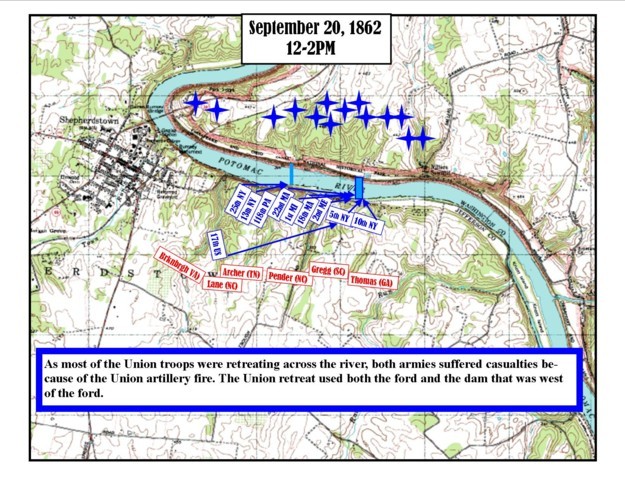
Map: September 20, 1862, 2PM-3PM
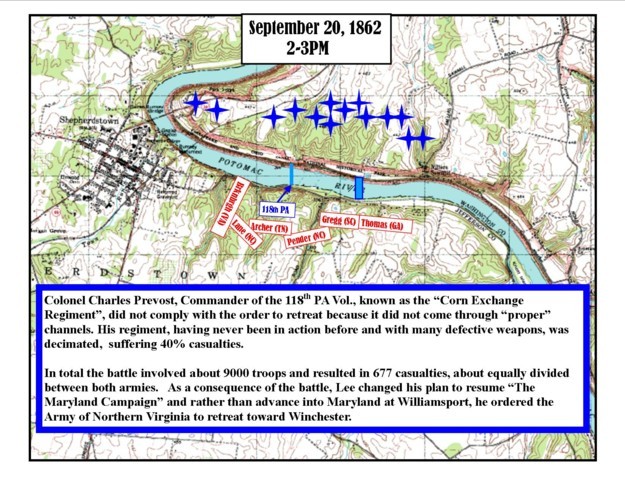
"Boteler's Ford, Potomac River near Shepherdstown. Point at which Confederate Army crossed after battle of Antietam." (Library of Congress)
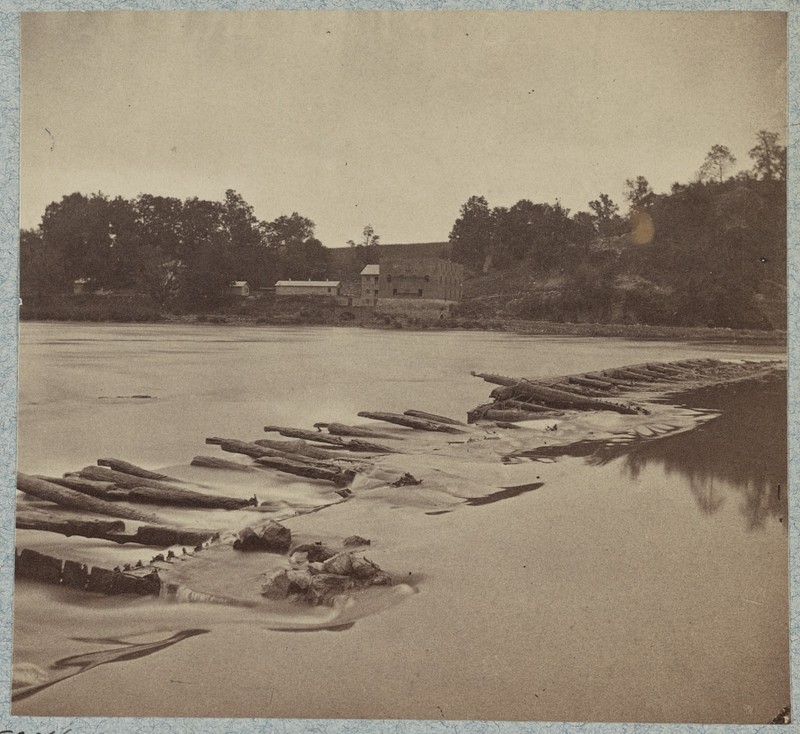
"Ford near Shepherdstown, on the Potomac. Pickets firing across the river." September 1862, sketch by Alfred R. Waud (Library of Congress)
.jpg)
"The Philadelphia Corn Exchange Regiment Fording The Potomac Near Shepherdstown.-sketched by A. R. Waud." Harper's Weekly, October 11, 1862.
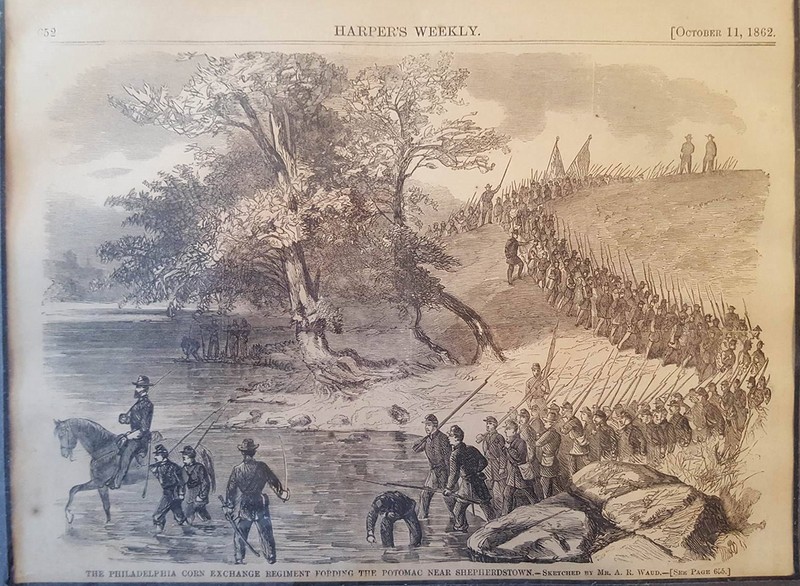
View of the cliffs and cement mill from Maryland side of Potomac (c. 1870)
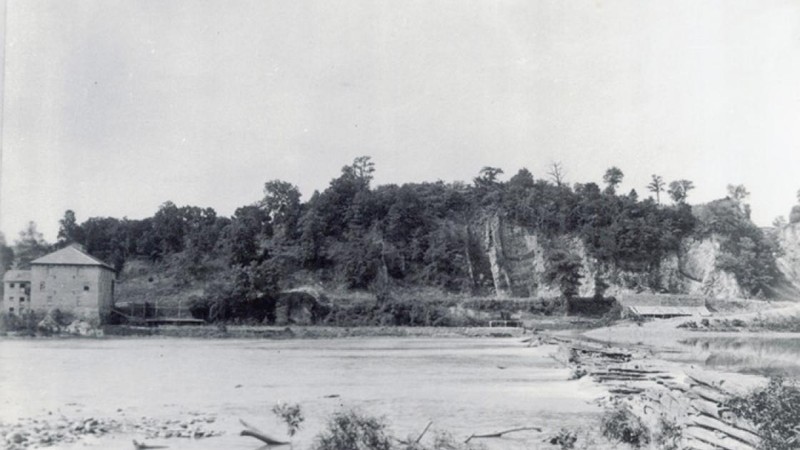
"Ruins of bridge, across Potomac River at Shepherdstown." (Library of Congress)
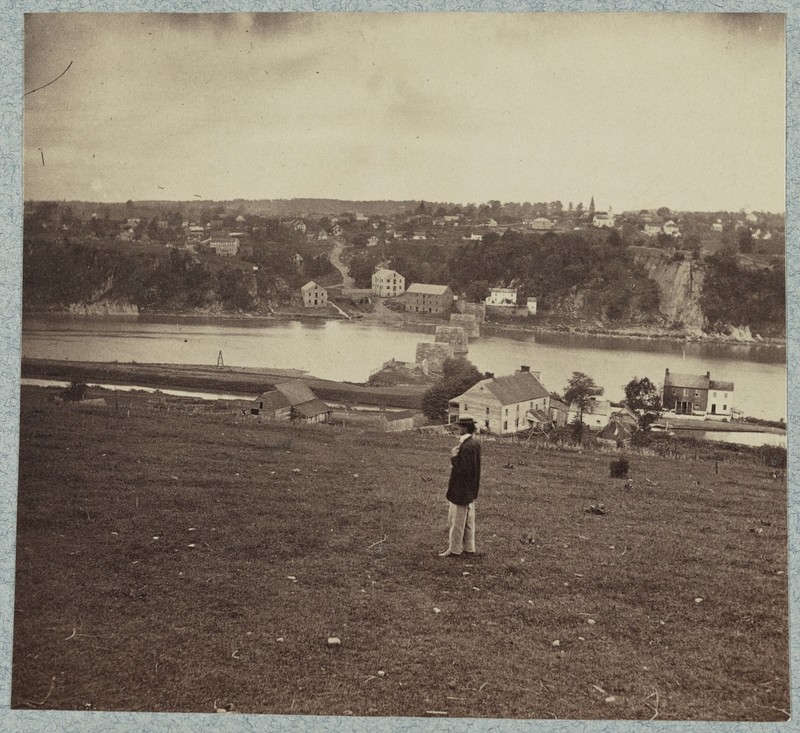
General William Pendleton

General Alfred Pleasonton
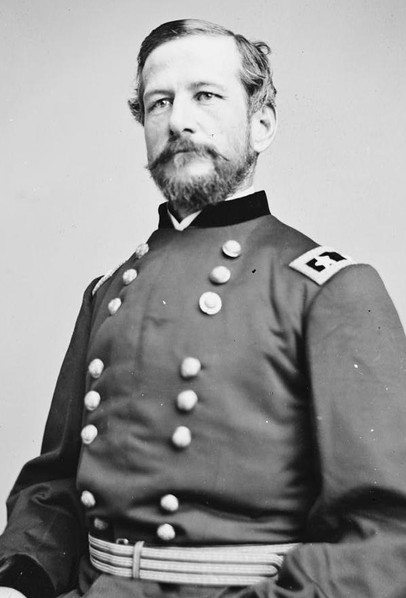
General Fitz John Porter
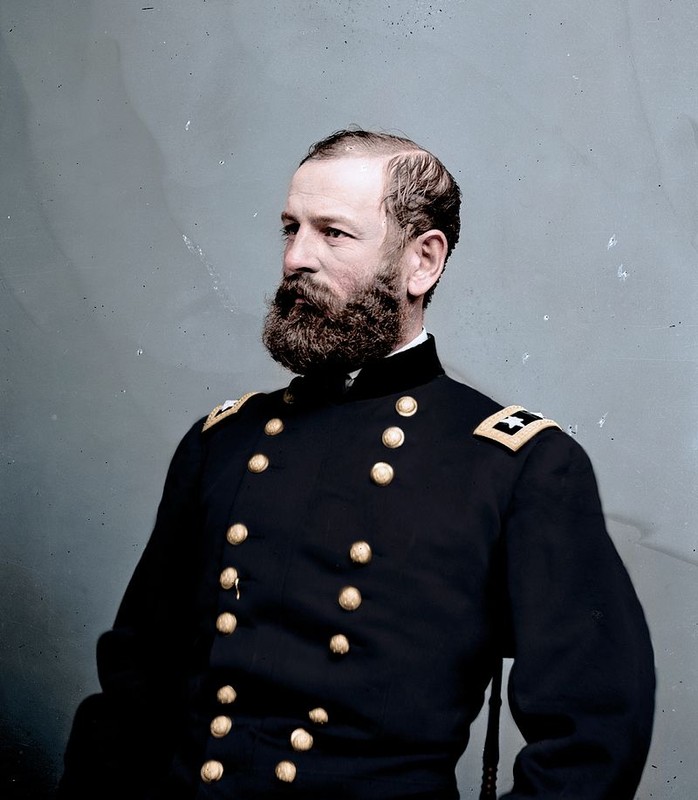
Major General George W. Morell
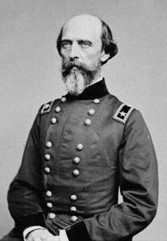
General A. P. Hill
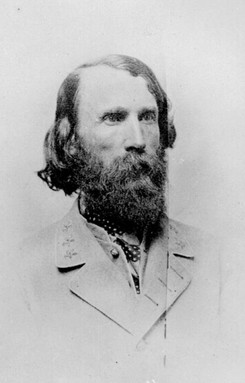
Colonel Charles M. Prevost of the 118th PA
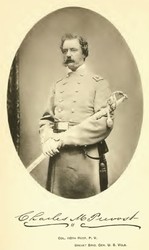
Brigadier General William Dorsey Pender
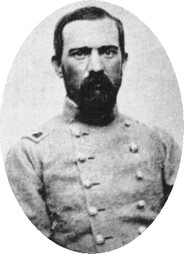
Brigadier General Maxcy Gregg

Brigadier General Edward Thomas
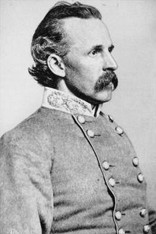
Backstory and Context
Text-to-speech Audio
On September 17, 1862 the armies of Generals George McClellan and Robert E. Lee fought to a bloody stalemate at the Battle of Antietam near Sharpsburg, MD. On September 18, Lee ordered the Confederate army to withdraw from the battlefield and retreat back to Virginia. They used the ford near Shepherdstown, VA (now WV) known as Blackford’s, Pack Horse, or Boteler’s/Butler’s Ford. Cavalry under Fitzhugh Lee guarded Lee’s crossing at the ford while the rest of the Confederate cavalry rode to Williamsport. The Confederate army finished crossing the ford without any resistance on the morning of September 19th.
As the Confederate wounded streamed into Shepherdstown and the surrounding area, and Lee’s army pushed on in its retreat, Brigadier General William Pendleton was ordered to guard the ford to prevent a Union pursuit. He had a force of Lee’s reserve artillery (10 batteries) and about 600 infantry on the Virginia side to protect Lee’s retreat. Once Lee had successfully left Sharpsburg, Union General McClellan sent cavalry under Brigadier General Alfred Pleasonton to follow. He captured 167 prisoners from rear elements of Lee’s retreat, placed artillery (3 batteries of the 2nd U.S. Artillery) on the Maryland side of the Potomac, and began firing across the river towards Shepherdstown and the Confederate forces. This cannonade between the artillery lasted for a couple of hours while Union infantry from the 5th Corps under Fitz John Porter came up and got into position on the Maryland side of the river.
In the afternoon of September 19th, Union soldiers from Major General George W. Morrell’s division, Union 5th Corps, crossed the Potomac and engaged with the Confederate rearguard, successfully pushing back the Confederate skirmishers. Later in the evening Porter sent the 4th Michigan across to scavenge the abandoned Confederate equipment, securing several of the abandoned guns. After this assault, Pendleton retreated and reported to General Lee that his position and all of his guns were lost. Hearing this news, General Thomas “Stonewall” Jackson ordered A. P. Hill to turn back and take his force to Shepherdstown to protect the crossing. Hill discovered that in reality only four or five of Pendleton’s guns had been taken by the Union.
A. P. Hill placed his troops southeast of Shepherdstown, near the road to Moler’s Cross Roads, and sent the brigades of William Pender, Maxcy Gregg, and Edward Thomas to the front. Hill had artillery but was unable to get them to the front in time for the engagement. On the morning of September 20, Porter sent two brigades from Morrell’s division across the Potomac to capitalize on the success of the previous night. Climbing the bluffs near the cement mill (Potomac Mills) and using the Trough Road, the Union infantry deployed in the field west of the road. The Union troops met Hill’s force at the top of the bluffs and were surprised by the large Confederate force in front of them. Hill’s troops were able to overwhelm the Union force and cause them to retreat. Unfortunately for the Union men, this meant retreating down the bluffs and cliffs, 50-70 feet high, and escaping across the open river under Confederate fire. The Confederate forces were able to inflict many casualties as the Union troops tried to retreat down the bluffs and across the Potomac.
The biggest loss was in the 118th Pennsylvania Infantry. A brand-new unit of green troops, the Colonel of the 118th PA refused an order to retreat and his men became trapped between the bluffs and the oncoming Confederates. In the fight, many of the men discovered that their newly issued Enfield rifles were defective and would not fire, giving them no means of defense. Of the 363 Union casualties of the Battle of Shepherdstown, 269 were from the 118th Pennsylvania. The regiment reported 36% casualties (269 out of 739 men engaged), and Shepherdstown was the unit’s first and deadliest battle of the entire war.
With 624 casualties—363 Union and 261 Confederate—the Battle of Shepherdstown is the largest engagement fought in the modern state of West Virginia (it was still Virginia at the time of the battle in 1862). It was largely inconsequential in the course of the Antietam Campaign because it essentially harassed, but did not stop, Lee’s retreat. However, for the men engaged in the battle it was considered a significant event, particularly for the new troops of the 118th PA.
About the Monuments:
This series of monuments and accompanying tour pamphlet were part of an initiative from the Jefferson County Camp, United Confederate Veterans to commemorate the 50th anniversary of the Civil War. In 1910 Col. R. Preston Chew and the Jefferson County UCV raised the funds to place 25 concrete obelisks in Jefferson County to mark locations of engagement or other significant events. The following year the Camp published a pamphlet to accompany the obelisks and give more information about each location. This was Military Operations in Jefferson County, Virginia (Now West Virginia), 1861-1865 published in 1911. The pamphlet has been reprinted several times by the Henry Kyd Douglas Camp, No. 199 of the Sons of Confederate Veterans. Because the monuments and accompanying pamphlet were done by Confederate veterans it is likely that the locations and descriptions are biased towards or favor the Confederate view and experience of the war.
Original Text from the 1911 Pamphlet:
Marker Number Four
Slaughter at the Cement Mill on the Potomac
Confederate Marker No. 4, is planted at the crossing of the Shepherdstown and Harpers Ferry and the Trough roads, locally called Showman’s Shop. At this point A. P. Hill, on the early morning of the Twentieth of September, 1862, placed his division in line of battle, with skirmishers, to the front, extending east and west and on the north side of the Shepherdstown and Harpers Ferry road. Three brigades of the division were advanced to the front, and the other forces followed in reserve. There was little opportunity for artillery on the Confederate side, as these three brigades were advanced at the double quick, and never halted until the field was won.
The Battle of Sharpsburg was fought on the Seventeenth of September; both armies lay inactive on the Eighteenth, and Lee recrossed the Potomac on that night.
Lawton’s and Armisted’s brigades, with forty-four cannon were posted on the Virginia bluffs to guard the ford. Lee’s withdrawal was accomplished without loss. By early dawn on the Nineteenth, the Federals had placed cannon on every available position on the Maryland bluffs, and heavy cannonading commenced and continued for several hours, with some losses on both sides. The infantry sharpshooters exchanged shots across the river with little effect. The artillery was withdrawn, and the infantry quietly followed. Two disabled cannon and caisson were abandoned (not captured). Brigadier-General Griffin, with four regiments of infantry, crossed over to the Virginia side after the withdrawal of the Confederates, with no opposition except the rear guard. They remained several hours, then recrossed, taking the disabled guns with him.
Longstreet’s Corps moved on to the Valley pike, some twenty miles away. Jackson’s Corps was near Charles Town, with the exception of A. P. Hill’s Division which had been left in a large body of timber about three and one-half miles from the Potomac River, with Early’s Brigade in supporting distance, if needed.
The plan was well conceived and carried out, as after events proved.
Hill was informed of every movement of the enemy. Scouts crossed the river and obtained information from known citizens; and the rumble of artillery wheels on the Maryland side was heard by our pickets along the Potomac, and word sent to Hill. Troops soon began to cross. Courier after courier kept him informed of these events; and, when they were ready to advance, Hill was on the field and ready.
The Federal forces that crossed over, and Hill had to oppose were Major General Lovell’s Brigade, the First, Second, Sixth, Tenth, Eleventh and Seventeenth United States Infantry. Syke’s Division, Fifth Corps. They moved up the Trough road and fronted Hill’s right; and Barnes’s Brigade took position on the cliffs along the river road. His command consisted of the following regiments: Eighteenth and Twenty-second Massachusetts Infantry, Second Maine, First Michigan, Thirteenth and Twenty-fifth New York, One Hundred and Eighteenth Pennsylvania, one company of Sharpshooters, 1 regiment of Cavalry, which had crossed with Sykes, and three batteries of Artillery posted on the Maryland bluffs commanded by Weed, Randol and VanReed.
The Federal forces were rapidly driven toward the Potomac, and hurriedly crossed over. That portion of Barnes’s command whose line of retreat was toward the high precipitous bluffs, directly above the Cement Mill, suffered heaviest loss. Those that did not surrender were driven over the bluffs at places from fifty to eighty feet high. Some reached the bottom in safety, some hung on snags and rock ledges, and some that feel clear were crushed.
The One Hundred and Eighteenth Pennsylvania Volunteers, known as the Corn Exchange Regiment, suffered most. It crossed the river with seven hundred and thirty-seven officers and men, and recrossed it with four hundred and sixty-eight (their account). Numbers were shot in the river. The entire Confederate loss was thirty-four killed and two hundred and thirty-one wounded.
A. P. Hill’s Division, at this time, did not number over 4000 men. It was one of the strongest divisions in the early spring of ’62, but the Seven Days Battle below Richmond, where they did some of the hardest fighting, their losses at Cedar Mountain and Second Manassas also, were great; and the long march around Pope to Manassas and to Williamsport, and back to Harpers Ferry, made hundreds of them shoeless and foot sore. Then at Sharpsburg they had losses, making their numbers in the three brigades that were engaged about 2500 men. This estimate is made by responsible men who served in the Division.
Some companies had not more than ten men, and some few had less.
This battle is known as the battle of Cement Mill, or Butler’s Ford. It was fought without cannon on the Confederate side; and the Federals would have fared better if they had not used any; for, when the Confederates had closed upon the Federals, they did about equal execution to both.
After the battle was over, A. P. Hill wanted to know the situation on the other side, and Major Gilmore volunteered to ride up the river road, within range of thousands of muskets and about forty cannon, and not a shot was fired at him, the distance being about three-quarters of a mile.
After this repulse, the Confederates picketed at this ford unmolested.
A. P. Hill issued the following address to the Division after this battle:—
“Soldiers of the Light Division, you have done well. I am well pleased with you. You have fought in every battle from Mechanicsville to Shepherdstown, and no man can say the Light Division was ever broken. You held the left at Manassas against overwhelming numbers and saved the army. You saved the day at Sharpsburg and at Shepherdstown. You were selected to face a storm of round shot, shell, and grape, such as I have never before seen.
I am proud to say to you that your services are appreciated by your General; and that you have a reputation in the army which should be the object of every officer and private to sustain. A.P. HILL, MAJOR-GENERAL.”
Cite This Entry
Historic Landmarks Commission, Jefferson County and Kathleen Thompson. "UCV Civil War Military Operations Marker #4: Battle of Shepherdstown, September 19-20, 1862." Clio: Your Guide to History. February 17, 2021. Accessed March 18, 2025. https://theclio.com/entry/77051
Sources
Bushong, Millard Kessler. A History of Jefferson County, West Virginia. Charles Town, WV: Jefferson Publishing Company, 1941.
Engle, Stephen Douglas. Thunder in the Hills: Military Operations in Jefferson County, West Virginia, During the American Civil War. Charleston, WV: Mountain State Press, 1989.
Military Operations in Jefferson County Virginia (and West Va.) 1861-1865. Published by Authority of Jefferson County Camp U.C.V. Farmers Advocate Print, 1911. Accessed January 20, 2021. https://babel.hathitrust.org/cgi/pt?id=uc2.ark:/13960/t4vh5gp6c&view=1up&seq=5.
Murfin, James V. The Gleam of Bayonets: The Battle of Antietam and Robert E. Lee’s Maryland Campaign, September 1862. Baton Rouge: Louisiana State University, 2004.
Redding, Nicholas A. A History and Guide to Civil War Shepherdstown: Victory and Defeat in West Virginia’s Oldest Town. Lynchburg, VA: Schroeder Publications, 2012.
Snell, Mark A. West Virginia and the Civil War: Mountaineers Are Always Free. Charleston, SC: The History Press, 2011.
"Shepherdstown--September 20, 1862." American Battlefield Trust. Accessed January 22, 2021. https://www.battlefields.org/learn/maps/shepherdstown-september-20-1862.
"Maps of the Battle of Shepherdstown." Shepherdstown Battlefield Preservation Association. Accessed January 24, 2021. http://shepherdstownbattlefield.org/1862battlemaps/
"Maps of the Battle of Shepherdstown." Shepherdstown Battlefield Preservation Association. Accessed January 24, 2021. http://shepherdstownbattlefield.org/1862battlemaps/
"Maps of the Battle of Shepherdstown." Shepherdstown Battlefield Preservation Association. Accessed January 24, 2021. http://shepherdstownbattlefield.org/1862battlemaps/
"Maps of the Battle of Shepherdstown." Shepherdstown Battlefield Preservation Association. Accessed January 24, 2021. http://shepherdstownbattlefield.org/1862battlemaps/
"Maps of the Battle of Shepherdstown." Shepherdstown Battlefield Preservation Association. Accessed January 24, 2021. http://shepherdstownbattlefield.org/1862battlemaps/
"Maps of the Battle of Shepherdstown." Shepherdstown Battlefield Preservation Association. Accessed January 24, 2021. http://shepherdstownbattlefield.org/1862battlemaps/
Boteler's Ford, Potomac River near Shepherdstown. Point at which Confederate Army crossed after battle of Antietam. United States Shepherdstown West Virginia, None. [Photographed between 1861 and 1865, printed between 1880 and 1889] Photograph. https://www.loc.gov/item/2014646041/. Accessed January 25, 2021. https://www.loc.gov/item/2014646041/.
Waud, Alfred R. , Artist. Ford near Shepherdstown, on the Potomac. Pickets firing across the river. United States Sheperdstown Virginia Potomac River, 1862. [September] Photograph. https://www.loc.gov/item/2004660886/. Accessed January 24, 2021. https://www.loc.gov/resource/ppmsca.21392/.
"The Battle of Shepherdstown." Historic Shepherdstown & Museum. Accessed January 24, 2021. https://historicshepherdstown.com/portfolio-item/the-battle-of-shepherdstown/.
"Book: A History and Guide to Civil War Shepherdstown." American Battlefield Trust. Accessed January 24, 2021. https://www.battlefields.org/learn/articles/book-history-and-guide-civil-war-shepherdstown. Photo is on p. 101 of Redding's book with caption information.
Ruins of bridge, across Potomac River at Shepherdstown. United States Shepherdstown West Virginia, None. [Photographed between 1861 and 1865, printed between 1880 and 1889] Photograph. https://www.loc.gov/item/2014646040/. Accessed January 25, 2021. https://www.loc.gov/item/2014646040/.
"William N. Pendleton." Wikipedia. Accessed January 24, 2021. https://en.wikipedia.org/wiki/William_N._Pendleton
"Alfred Pleasonton." Wikipedia. Accessed January 24, 2021. https://en.wikipedia.org/wiki/Alfred_Pleasonton.
"Fitz John Porter." Wikipedia. Accessed January 24, 2021. https://en.wikipedia.org/wiki/Fitz_John_Porter.
"George W. Morell." Wikipedia. Accessed January 24, 2021. https://en.wikipedia.org/wiki/George_W._Morell.
"A. P. Hill." Wikipedia. Accessed January 24, 2021. https://en.wikipedia.org/wiki/A._P._Hill.
"On the trail of the Corn Exchange Regiment." behind AotW. Accessed January 25, 2021. http://behind.aotw.org/2008/10/05/on-the-trail-of-the-corn-exchange-regiment/.
"William Dorsey Pender." Wikipedia. Accessed January 24, 2021. https://en.wikipedia.org/wiki/William_Dorsey_Pender.
"Maxcy Gregg." Wikipedia. Accessed January 24, 2021. https://en.wikipedia.org/wiki/Maxcy_Gregg.
"Edward Lloyd Thomas." Wikipedia. Accessed January 24, 2021. https://en.wikipedia.org/wiki/Edward_Lloyd_Thomas.

